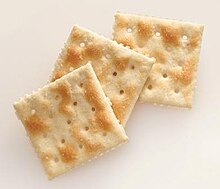Saltine cracker
This article needs additional citations for verification. (November 2009) |
 | |
| Alternative names | Soda cracker |
|---|---|
| Type | Cracker |
| Place of origin | United States |
| Main ingredients | Flour, yeast, and baking soda |
A saltine or soda cracker is a thin, usually square cracker made from white flour, yeast, and baking soda, with most varieties lightly sprinkled with coarse salt. It has perforations over its surface. It has a very dry and crisp texture.
Some familiar brand names of saltine crackers in North America are Christie's Premium Plus (Canada), Nabisco's Premium (U.S.), Sunshine Biscuits' Krispy (U.S.) and Keebler's Zesta (U.S.) (both owned by Kellogg's). Saltín Noel by Colombian company Noel is also a favorite among some parts of the U.S. Hispanic community. Unsalted tops as well as whole grain saltines can also be found.
Uses
Saltines are often eaten as a light snack, often with cheese, butter or peanut butter. They may also be dipped or crumbled in stews, chilis, soups or dips, or crumbled into salads. Typically they are sold in boxes containing two to four stacks of crackers, each wrapped in a sleeve of waxed paper or plastic. In restaurants, they are found in small wrapped packets of two crackers, which generally accompany soup or salad. Cracker meal, a type of coarse to semi-fine flour made of crushed saltine crackers, may be used as toppings for dishes; breading for fried or baked red meats, poultry, fish or tofu; or as a thickener for soups, stews, sauces, and chilis.
As a home remedy, saltines are consumed by many people in order to ease nausea and to settle an upset stomach. Pregnant women are also usually advised to snack on saltines. For some children, eating saltines on Christmas Eve is a family tradition.[citation needed] Saltine crackers have also been included in military field rations (Meal, Ready-to-Eat, or MRE) in the United States.
History
Various versions of unleavened dry crackers known as hardtack have been around for thousands of years. The generally thick hardtack cracker was extremely long-lasting, but bland and difficult to eat.
In 1876, F. L. Sommer & Company of St. Joseph, Missouri started using baking soda to leaven its wafer thin cracker. Initially called the Premium Soda Cracker and later "Saltines" because of the baking salt component, the invention quickly became popular and Sommer's business quadrupled within four years. That company merged with other companies to form American Biscuit Company in 1890 and then after further mergers became part of Nabisco in 1898.[1][2][3]
In the United States, Nabisco lost trademark protection after the term began to be used generically to refer to similar crackers. The name "saltine" had been placed in the Merriam Webster Dictionary in 1907 with a definition of "a thin crisp cracker usually sprinkled with salt”.[4] In Australia, Arnott's Biscuits Holdings still holds a trademark on the name "Saltine".[5][6]
They were made in the United Kingdom by Huntley and Palmers, and also in Australia and New Zealand under the brand name Arnott's Salada.
Baking process
Saltines have been compared to hardtack, a simple unleavened cracker or biscuit made from flour, water, and salt. However, unlike hardtack, saltines actually do include yeast as one of their ingredients. Soda crackers are a leavened bread that is allowed to rise for twenty to thirty hours. After the rise, alkaline soda is added to neutralize the excessive acidity produced by the action of the yeast. The dough is allowed to rest for three to four more hours, to relax the gluten, before being rolled in layers and then baked.
Flat saltine crackers have perforations on their surfaces. During baking, the outer layer of dough hardens first, restricting out-gassing of evolved gasses. The perforations connect the top surface to the bottom surface to prevent the cracker from pillowing as a result of these evolved gasses.
See also
References
- ^ "Soggy Cracker House Needs Some Help". St. Joseph News-Press. 15 April 2008. Retrieved October 12, 2013.
- ^ "Biographical Sketch of F. L. Sommer, St. Joseph, Buchanan County, MO". USGenWeb Archives. Retrieved 2013-03-27.
- ^ "Michigan State University Libraries - Special Collections - Little Cookbooks: The Alan and Shirley Brocker Sliker Culinary Ephemera Collection". Lib.msu.edu. Retrieved 2012-09-26.
- ^ "Nabisco Premium Saltines The Snack That Takes You Back" (PDF). SaigeFalyn. Retrieved 2013-03-27.
- ^ "Trade Mark Details - Full - Trade Mark : 214303". ipaustralia.gov.au. Retrieved 2013-10-29.
- ^ "Trade Mark Details - Full - Trade Mark : 98208". ipaustralia.gov.au. Retrieved 2013-10-29.
